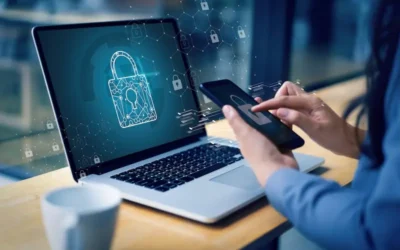Over the past two and a half years, hybrid working models have empowered employees to balance both remote and in-office working arrangements, choosing where they work, and oftentimes when they work. Such a significant change has left businesses with a very real concern about how to protect their hybrid workplace from cyber attacks.
Workers across the board overwhelmingly love the flexibility and convenience that hybrid working offers, and many companies have therefore been adapting hybrid working models into their daily operations.
However, these changes present several security challenges and can leave companies vulnerable to cyber attacks by criminals and malicious actors, so in this article, we’ll provide you with some tips on how to keep your hybrid workplace safe.
Cyber attacks in a changing workplace landscape
The shift to hybrid working models has increased the opportunities available to cyber criminals. For example, an increase in the travel of both employees and work devices between on-site and remote locations presents a security risk.
With purely remote work, devices remained in employees’ homes, isolated from the office environment. But with a hybrid work environment, malware has more opportunities to spread as people access different networks at different times.
Any business today should have legitimate concerns about managing its cybersecurity, especially when operating a hybrid working model.
Here are some of the cybersecurity risks involved so you can identify them early and take steps to mitigate them.
The risks of cyber attacks in a hybrid working model
Unsecured user devices
Companies with BYOD (Bring Your Own Device) policies face serious security risks because employees don’t always install the company’s security and monitoring programs on personal devices.
Furthermore, patches and updates cannot be pushed reliably by one authoritative source (say, the IT department), which can put the entire organisation at risk.
Data is transferred in an unsecured manner
Protecting sensitive company data is difficult when employees can work from home, at a local coffee shop, or in similar locations.
These places don’t offer the same security as an internal office system and company data can be vulnerable to unsecured public Wi-Fi with little or no encryption.
Flawed user behaviour
Humans are the weakest link in any cybersecurity chain, and hybrid work could be seen as encouraging risky behaviour, particularly if your IT security policies and procedures haven’t been expanded to comprehensively cover hybrid working scenarios.
For example, in many hybrid models where security policies have been slow to catch up, workers are using their own devices and are free to install apps without IT approval. This dramatically increases the possibility of malware infections.
It is also worth noting that phishing attacks happen more frequently on weekends because employees are now using work devices for personal use more frequently and often forget about specific security protocols they should be adhering to.
Unsecured home networks – easy prey for cyber attacks
While most remote workers password-protect their home Wi-Fi networks, they often think that this is enough to keep their data secure.
They are mostly unaware of proper and effective Wi-Fi security standards, making it easier for cybercriminals to access and steal commercial data from their domestic networks.
Lost or stolen devices
Generally speaking, it’s much easier to keep work devices and data safe in an office environment. However, as workers frequently travel between home and office, the risk of losing work devices increases exponentially.
Theft or loss of expensive phones and laptops is common, especially in airports, restaurants, and vehicles. Such theft or misplacement can have potentially devastating consequences in terms of financial and reputational losses.
Phishing attacks
Remote workers are an attractive target for phishing attacks and social engineering attacks because they tend to let their guard down when they are not in a workplace setting, surrounded by colleagues and constant reminders about cybersecurity practices.
They also get more used to communicating with their colleagues and superiors on a purely electronic basis. This has made many remote workers less likely to ask for a second opinion before opening and engaging with emails from both known contacts and unusual sources.
Inconsistent patching and updating
Even today, most workers still don’t fully grasp the importance of installing security patches and often disregard upgrade notifications.
This usually occurs simply because they are either reluctant to reboot their machines which can be maddening for any company’s IT security team!
Strategies to reduce hybrid model cyber attacks
The hybrid working model both introduces new cybersecurity risks and exacerbates existing ones, but there are several steps organisations and employees can take to mitigate such threats:
Act rather than react
A few simple preventive steps can save an organisation from potential catastrophe down the road:
- Educate your employees about cyber security risks and best practices and give them a list of dos and don’ts to adhere to
- Introduce strict protocols relating to device usage and enforce them with monitoring software and frequent reviews
- Review your IT systems for cybersecurity risks with experienced professionals and take corrective action before an attack occurs
Recognise the early warning signs
Employees must learn to watch out for the tell-tale warning signs of a cyberattack.
One example would include an inexplicable slowdown of the network or the unexpected arrival of emails urgently requesting funds or confidential data.
These are likely indications that an attacker has gained access to your system.
Use a VPN to make cyber attacks more difficult
Invest in a VPN (Virtual Private Network) from a reputed company and enforce its usage.
A VPN encrypts the data you send and also anonymises your online presence, so attackers have a much more difficult time identifying or targeting your employees.
Implement a zero-trust approach
The zero-trust model recommends that you “never trust, always verify”.
This cybersecurity philosophy assumes that every access request could be malicious, so it enforces authorisation, authentication, and encryption regardless of origin and resource.
It also applies least-privilege access principles and can be very effective in minimising the impact of cyber attacks.
Use secure and reputable tools
Do not allow your staff to use arbitrary tools that come from potentially unsecured sources and unlicensed developers. Instead, give them a set of defined tools that all staff members are allowed to use and make sure that they are well-established and reputable from a security standpoint.
Having a standardised set of tools and apps across your organisation will increase your team’s productivity and using well-established software will make your workplace safer as they are constantly maintained and updated by experienced professionals.
Employ Multi-Factor Authentication
Password-based attacks are becoming increasingly sophisticated, so you should not rely on passwords alone to give individuals access to company assets.
Instead, implement Multi-Factor Authentication in all scenarios that require verification. This will help to minimise potential breaches.
Invest in cybersecurity training
Generally speaking, employees are simply not aware of all of the cyber security threats that they are facing daily. Therefore, companies should routinely train their employees on the most common security threats and how to mitigate them.
Employees should understand that cyber security is everyone’s responsibility, not only that of your IT department and it’s important that their responsibilities are underscored by thorough and regular training.
Undertake vulnerability assessments
To be fully aware of security threats lurking in your system, it is worth contracting a competent third party to probe your systems and perform a vulnerability assessment.
A third-party cyber security specialist will be able to tell you if you have any gaps in your cybersecurity infrastructure and can then provide guidance on how to fix them.
Employ email filtering
Emails are the most common vehicle for spreading malware and launching social engineering scams. To prevent this, your company should install email filters that will automatically scan the content, detect malware, evaluate links and sources and block any malicious emails.
While this approach will never be 100% effective, it will do a good job as an initial line of defence that serves to weed out potential malware and phishing attacks.
Data encryption thwarts cyber attacks
All businesses should encrypt data both in transit and at rest. Efforts should be made to encrypt the contents of all company hard disks and devices so that any data cannot be accessed even if the device in question gets lost or stolen.
Protect your hybrid workforce from cyber attacks
The best thing you can do right now to protect your business is to partner up with a trusted IT Managed Service Provider (MSP) like Calnet IT Solutions.
As part of our overall MSP coverage, we can provide your organisation with comprehensive cybersecurity protection, train your employees to handle cybersecurity situations and perform ongoing, intermittent testing to see how your team stack up against common cyber attacks.
Get in touch today to see how we can comprehensively protect your business and your employees, irrespective of what working model you choose to utilise.
Also, make sure to check out our blog and resources to learn more about the latest trends in cybersecurity so you can ensure you always stay ahead of the curve.







